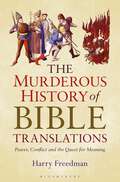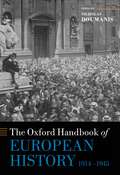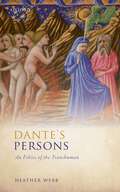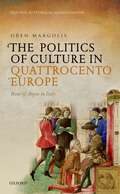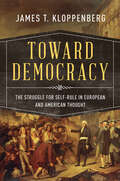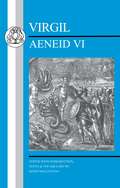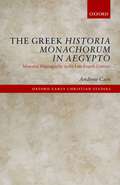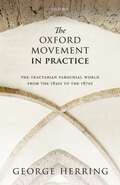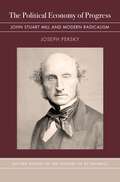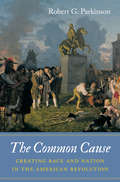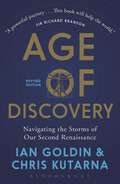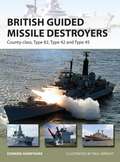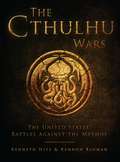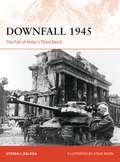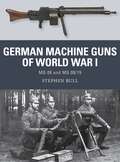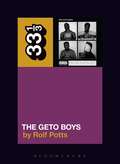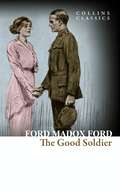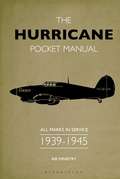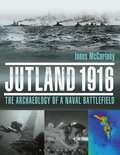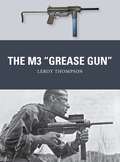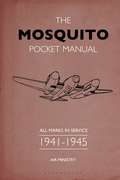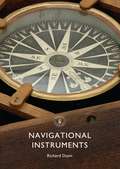- Table View
- List View
The Murderous History of Bible Translations: Power, Conflict and the Quest for Meaning
by Harry FreedmanIn 1535, William Tyndale, the first man to produce an English version of the Bible in print, was captured and imprisoned in Belgium. A year later he was strangled and then burned at the stake. His co-translator was also burned. In that same year the translator of the first Dutch Bible was arrested and beheaded. These were not the first, nor were they the last instances of extreme violence against Bible translators. The Murderous History of Bible Translations tells the remarkable, and bloody, story of those who dared translate the word of God.The Bible has been translated far more than any other book. To our minds it is self-evident that believers can read their sacred literature in a language they understand. But the history of Bible translations is far more contentious than reason would suggest. Bible translations underlie an astonishing number of religious conflicts that have plagued the world.Harry Freedman, author of The Talmud: A Biography describes brilliantly the passions and strong emotions that arise when deeply held religious convictions are threatened or undermined. He tells of the struggle for authority and orthodoxy in a world where temporal power was always subjugated to the divine. A world in which the idea of a Bible for all was so important that many were willing to give up their time, their security and often their lives.
The Oxford Handbook of European History, 1914-1945 (Oxford Handbooks)
The period spanning the two World Wars was unquestionably the most catastrophic in Europe's history. Despite such undeniably progressive developments as the radical expansion of women's suffrage and rising health standards, the era was dominated by political violence and chronic instability. Its symbols were Verdun, Guernica, and Auschwitz. By the end of this dark period, tens of millions of Europeans had been killed and more still had been displaced and permanently traumatized. If the nineteenth century gave Europeans cause to regard the future with a sense of optimism, the early twentieth century had them anticipating the destruction of civilization. The fact that so many revolutions, regime changes, dictatorships, mass killings, and civil wars took place within such a compressed time frame suggests that Europe experienced a general crisis. The Oxford Handbook of European History, 1914-1945 reconsiders the most significant features of this calamitous age from a transnational perspective. It demonstrates the degree to which national experiences were intertwined with those of other nations, and how each crisis was implicated in wider regional, continental, and global developments. Readers will find innovative and stimulating chapters on various political, social, and economic subjects by some of the leading scholars working on modern European history today.
Dante's Persons: An Ethics of the Transhuman
by Heather WebbDante's Persons explores the concept of personhood as it appears in Dante's Commedia and seeks out the constituent ethical modes that the poem presents as necessary for attaining a fullness of persona. The study suggests that Dante presents a vision of 'transhuman' potentiality in which the human person is, after death, fully integrated into co-presence with other individuals in a network of relations based on mutual recognition and interpersonal attention. The Commedia, Heather Webb argues, aims to depict and to actively construct a transmortal community in which the plenitude of each individual's person is realized in and through recognition of the personhood of other individuals who constitute that community, whether living or dead. Webb focuses on the strategies the Commedia employs to call us to collaborate in the mutual construction of persons. As we engage with the dead that inhabit its pages, we continue to maintain the personhood of those dead. Webb investigates Dante's implicit and explicit appeals to his readers to act in relation to the characters in his otherworlds as if they were persons. Moving through the various encounters of Purgatorio and Paradiso, this study documents the ways in which characters are presented as persone in development or in a state of plenitude through attention to the 'corporeal' modes of smiles, gazes, gestures, and postures. Dante's journey provides a model for the formation and maintenance of a network of personal attachments, attachments that, as constitutive of persona, are not superseded even in the presence of the direct vision of God.
The Politics of Culture in Quattrocento Europe: René of Anjou in Italy (Oxford Historical Monographs)
by Oren MargolisThe poet-king without a throne appears here in an entirely new light. In The Politics of Culture in Quattrocento Europe: René of Anjou in Italy, Oren Margolis explores how this French prince and exiled king of Naples (1409-1480) engaged his Italian network in a programme of cultural politics conducted with an eye towards a return to power in the peninsula. Built on a series of original interpretations of humanistic and artistic material (chiefly Latin orations and illuminated manuscripts of classical texts), this is also a case study for a 'diplomatic approach' to culture. It recasts its source base as a form of high-level communication for a hyper-literate elite of those who could read the works created by humanist and artistic agents for their constituent parts: the potent words or phrases and relevant classical allusions; the channels through which a given work was commissioned or transmitted; and then the nature of the network gathered around a political agenda. This is a volume for all those interested in the politics and culture of later medieval Europe and Renaissance Italy: the kings of France and dukes of Burgundy, the Medici, the Sforza, the Venetians, and their armies, ambassadors, and adversaries all appear here; so do Giovanni Bellini, Andrea Mantegna, Guarino of Verona, and their respective intellectual and artistic circles. Emerging from it is a challenge to conventional interpretations of the politics of humanism, and a new vision of the Quattrocento: a century in which the Italian Renaissance began its takeover of Europe, but in which Renaissance culture was itself shaped by its European political, social, and diplomatic context.
Toward Democracy: The Struggle for Self-Rule in European and American Thought
by James T. KloppenbergIn this magnificent and encyclopedic overview, James T. Kloppenberg presents the history of democracy from the perspective of those who struggled to envision and achieve it. The story of democracy remains one without an ending, a dynamic of progress and regress that continues to our own day. In the classical age "democracy" was seen as the failure rather than the ideal of good governance. Democracies were deemed chaotic and bloody, indicative of rule by the rabble rather than by enlightened minds. Beginning in the 16th and 17th centuries, however, first in Europe and then in England's North American colonies, the reputation of democracy began to rise, resulting in changes that were sometimes revolutionary and dramatic, sometimes gradual and incremental. Kloppenberg offers a fresh look at how concepts and institutions of representative government developed and how understandings of self-rule changed over time on both sides of the Atlantic. Notions about what constituted true democracy preoccupied many of the most influential thinkers of the Western world, from Montaigne and Roger Williams to Milton and John Locke; from Rousseau and Jefferson to Wollstonecraft and Madison; and from de Tocqueville and J. S. Mill to Lincoln and Frederick Douglass. Over three centuries, explosive ideas and practices of democracy sparked revolutions--English, American, and French--that again and again culminated in civil wars, disastrous failures of democracy that impeded further progress. Comprehensive, provocative, and authoritative, Toward Democracy traces self-government through three pivotal centuries. The product of twenty years of research and reflection, this momentous work reveals how nations have repeatedly fallen short in their attempts to construct democratic societies based on the principles of autonomy, equality, deliberation, and reciprocity that they have claimed to prize. Underlying this exploration lies Kloppenberg's compelling conviction that democracy was and remains an ethical ideal rather than merely a set of institutions, a goal toward which we continue to struggle.
Virgil: Aeneid VI
by Virgil Keith MaclennanThis pivotal book of the Aeneid has Aeneas - like Odysseus in Odyssey XI - visiting the Underworld. He is poised, as it were, between the world of his 'Homeric' past, the wanderings he has undergone in the poem's first half, and the destiny mapped out for his descendants, which culminates in the age of Augustus and his lost successor Marcellus. Aeneas is at once a figure of past, present and future. This edition replaces the long-serving edition by Gould & Whiteley, making the book more accessible to today's students and taking account of the most recent scholarship and critical approaches to Virgil. It includes an introduction, annotation to explain language and content, and a comprehensive vocabulary.
Escape to Miami: An Oral History of the Cuban Rafter Crisis (Oxford Oral History Series)
by Elizabeth CampisiWhile the Naval base in Guantánamo Bay, Cuba is well-known for its infamous prison camp, few people are aware of its prior use as an immigrant detention center for Haitian and Cuban refugees. Beginning in August 1994, the United States government declared that thousands of Cubans who had launched themselves into the Florida Straits on rickety rafts were "illegal refugees" and sent them to join over fifteen thousand Haitians already being held on Guantánamo after fleeing a violent coup in Haiti. Escape to Miami recounts the gripping stories of the rafters who were detained in Guantánamo during the 1994-1996 Cuban Rafter Crisis. After working in the camps for a year as an employee of the U.S. Justice Department, Elizabeth Campisi conducted life history interviews with twelve of the rafters, chronicling their departures from Cuba, their rafting trips, life on the base, and their initial experiences in Cuban Miami. Through these remarkable narratives, the book details the ways in which the rafters used creative expression, such as performance and artwork, to cope with the traumas they experienced in the camp. Campisi explores these coping mechanisms, showing that, when people work through individually-traumatic experiences as a group, the new meanings they create during that process can come together to change existing cultures or create new ones. Vivid and engaging, Escape to Miami gives voice to the untold stories of Guantánamo. This book is a must-read for anyone interested in policy, Latin American history, and human rights.
The Greek Historia Monachorum in Aegypto: Monastic Hagiography in the Late Fourth Century (Oxford Early Christian Studies)
by Andrew CainThe Greek Historia Monachorum in Aegypto was one of the most widely read and disseminated Greek hagiographic texts during Late Antiquity and the Middle Ages. To this day it remains, alongside Athanasius' Life of Antony, one of the core primary sources for fourth-century Egyptian monasticism as well as one of the most fascinating, yet perplexing, pieces of monastic hagiography to survive from the entire patristic period. However, until now it has not received the intensive and sustained scholarly analysis that a monograph affords. In this study, Andrew Cain incorporates insights from source criticism, stylistic and rhetorical analysis, literary criticism, and historical, geographical, and theological studies in an attempt to break new ground and revise current scholarly orthodoxy about a broad range of interpretive issues and problems.
The Oxford Movement in Practice: The Tractarian Parochial World from the 1830s to the 1870s
by George HerringFrom its inception what came to be known as the Oxford Movement was always intended to be more than just an abstruse dialogue about the theoretical nature of Anglicanism. Instead, it was meant to spread its ideas not only through college common rooms, but also bishop's palaces, and above all the parsonages of the Church of England. The Oxford Movement in Practice presents an analysis of Tractarianism in the generation after Newman's conversion to Roman Catholicism. While much scholarly work has been done on the Oxford Movement between 1833 and 1845, and on a number of specific individuals or aspects of the Movement after this period, this work adopts a different approach. It examines Tractarianism in the parochial setting, and charts the development of the Movement through its influence on the parishes of the Church of England. George Herring offers detailed explanation of the development of ritualism in the 1860's, and shows how the Ritualists diverted the course the Movement had been taking from 1845.
The Political Economy of Progress: John Stuart Mill and Modern Radicalism (Oxford Studies in History of Economics)
by Joseph PerskyWhile there had been much radical thought before John Stuart Mill, Joseph Persky argues it was Mill, as he moved to the left, who provided the radical wing of liberalism with its first serious analytical foundation, a political economy of progress that still echoes today. A rereading of Mill's mature work suggests his theoretical understanding of accumulation led him to see laissez-faire capitalism as a transitional system. Deeply committed to the egalitarian precepts of the Enlightenment, Mill advocated gradualism and rejected revolutionary expropriation on utilitarian grounds: gradualism, not expropriation, promised meaningful long-term gains for the working classes. He endorsed laissez-faire capitalism because his theory of accumulation saw that system approaching a stationary state characterized by a great reduction in inequality and an expansion of cooperative production. These tendencies, in combination with an aggressive reform agenda made possible by the extension of the franchise, promised to provide a material base for social progress and individual development. The Political Economy of Progress goes on to claim that Mill's radical political economy anticipated more than a little of Marx's analysis of capitalism and laid a foundation for the work of Fabians and other gradualist radicals in the 20th century. More recently, modern philosophic radicals, such as Rawls, have deep links to this Millean political economy. These links are still worthy of development. In particular, a politically meaningful acceptance of Rawls's radical liberalism waits on a movement capable of re-engineering the workplace in a manner consistent with Mill's endorsement of worker management.
The Common Cause: Creating Race and Nation in the American Revolution (Published by the Omohundro Institute of Early American History and Culture and the University of North Carolina Press)
by Robert G. ParkinsonWhen the Revolutionary War began, the odds of a united, continental effort to resist the British seemed nearly impossible. Few on either side of the Atlantic expected thirteen colonies to stick together in a war against their cultural cousins. In this pathbreaking book, Robert Parkinson argues that to unify the patriot side, political and communications leaders linked British tyranny to colonial prejudices, stereotypes, and fears about insurrectionary slaves and violent Indians. Manipulating newspaper networks, Washington, Jefferson, Adams, Franklin, and their fellow agitators broadcast stories of British agents inciting African Americans and Indians to take up arms against the American rebellion. Using rhetoric like "domestic insurrectionists" and "merciless savages," the founding fathers rallied the people around a common enemy and made racial prejudice a cornerstone of the new Republic. In a fresh reading of the founding moment, Parkinson demonstrates the dual projection of the "common cause." Patriots through both an ideological appeal to popular rights and a wartime movement against a host of British-recruited slaves and Indians forged a racialized, exclusionary model of American citizenship.
Age of Discovery: Navigating the Risks and Rewards of Our New Renaissance
by Ian Goldin Chris KutarnaThe present is a contest between the bright and dark sides of discovery. To avoid being torn apart by its stresses, we need to recognize the fact-and gain courage and wisdom from the past. Age of Discovery shows how.Now is the best moment in history to be alive, but we have never felt more anxious or divided. Human health, aggregate wealth and education are flourishing. Scientific discovery is racing forward. But the same global flows of trade, capital, people and ideas that make gains possible for some people deliver big losses to others-and make us all more vulnerable to one another.Business and science are working giant revolutions upon our societies, but our politics and institutions evolve at a much slower pace. That's why, in a moment when everyone ought to be celebrating giant global gains, many of us are righteously angry at being left out and stressed about where we're headed.To make sense of present shocks, we need to step back and recognize: we've been here before. The first Renaissance, the time of Columbus, Copernicus, Gutenberg and others, likewise redrew all maps of the world, democratized communication and sparked a flourishing of creative achievement. But their world also grappled with the same dark side of rapid change: social division, political extremism, insecurity, pandemics and other unintended consequences of discovery.Now is the second Renaissance. We can still flourish-if we learn from the first.
British Guided Missile Destroyers: County-class, Type 82, Type 42 and Type 45 (New Vanguard)
by Paul Wright Edward HampshireIn the years after World War II, new guided missile technology offered surface ships the chance to destroy airborne threats from afar, thereby preserving their role in naval warfare. This book examines the technology and combat performance of Britain's guided missile destroyers over half a century.Uniquely among modern destroyers, three of these classes have been tested in battle against the aircraft and missiles of another modern navy - in the Falklands War - as well as being deployed during the Gulf War. Written by an expert on British naval technology, this book assess the changing technology of the Royal Navy's destroyers over half a century, including an examination of the Royal Navy's newest and most capable warship, the Type 45.
The Cthulhu Wars: The United States’ Battles Against the Mythos (Dark Osprey)
by Kenneth Hite Kennon Bauman Darren Tan Imaginary Friends StudiosFrom the Patriots' raid on the necromancer Joseph Curwen to the Special Forces' assault on Leng in 2007, this unique document reveals the secret and terrible struggle between the United States and the supernatural forces of Cthulhu. In this war, immortal cultists worship other-dimensional entities and plot to raise an army of the dead. Incomprehensible undersea intelligences infiltrate and colonize American seaports, and alien races lurk beneath the ice of Antarctica and high in the mountains of Afghanistan. It is only through constant vigilance and violence that the earth has survived. Also included are threat reports describing the indescribable – humanity's deadliest foes serving Cthulhu and the other Great Old Ones. Strange times are upon us, the world is changing, and even death may die – but, until then, the war continues.This product is not associated with the Cthulhu Wars tabletop game by Petersen Games, LLC; PetersenGames.com
Downfall 1945: The Fall of Hitler’s Third Reich (Campaign #293)
by Steven J. Zaloga Steve NoonAs the final month of fighting in Europe in 1945 dawned the Allies embarked upon a series of mopping up operations, destroying the last centres of German resistance as the essentially defeated Wehrmacht fought on in increasingly desperate conditions, driven on by the explicit no surrender order issued by Hitler.Yet at the same time, the Allied alliance was already on shaky ground, as German resistance was crushed the Allies began to eye each other nervously across a battletorn Europe, with the politically driven military decisions to have a huge impact on the future of the continent. This book traces the final operations of the war, from the liberation of Denmark, the Allied drive towards the Baltic straits, incursions in Yugoslavia, Hungary, Czechoslovakia and engagements in Eastern and Western Germany, whilst also analyzing how the Allied strategies in the final days of the war were a hint of the future difficulties that would drive the Cold War.
F4U Corsair vs Ki-84 "Frank†?: Pacific Theater 1945 (Duel #73)
by Jim Laurier Gareth Hector Edward M. YoungThe Vought Corsair was the first American single-engined fighter to exceed 400 mph and establish dominance over the legendary Mitsubishi Type Zero-sen. The Ki-84 Hayate was introduced by the Japanese specifically to counter this growing American dominance of the skies over the Pacific. Built in greater numbers than any other late war Japanese fighter, nearly 3000 were completed between 1944 and 1945. This volume examines the clashes between the Corsair and Ki-84 in the closing stages of the war, revealing how Corsair pilots had to adapt their techniques and combat strategies to adapt to these newer types. It also reveals how the kill rate was largely driven by the reduced quality of fighter pilots after the high casualty rates inflicted on the Japanese air force during the air battles over the Solomon Islands.
German Machine Guns of World War I: MG 08 and MG 08/15 (Weapon)
by Johnny Shumate Stephen Bull Alan GillilandWorld War I's defining weapon for many, Germany's MG 08 machine gun won a formidable reputation on battlefields from Tannenberg to the Somme. Although it was a lethally effective weapon when used from static positions, the MG 08 was far too heavy to perform a mobile role on the battlefield. As the British and French began to deploy lighter machine guns alongside their heavier weapons, the Germans fielded the Danish Madsen and British Lewis as stopgaps, but chose to adapt the MG 08 into a compromise weapon – the MG 08/15 – which would play a central role in the revolutionary developments in infantry tactics that characterized the last months of the conflict. In the 1940s, the two weapons were still in service with German forces fighting in a new world war. Drawing upon eyewitness battlefield reports, this absorbing study assesses the technical performance and combat record of these redoubtable and influential German machine guns, and their strengths and limitations in a variety of battlefield roles.
Geto Boys' The Geto Boys (33 1/3)
by Rolf PottsAt the outset of summer in 1990, a Houston gangsta rap group called the Geto Boys was poised to debut its self-titled third album under the guidance of hip-hop guru Rick Rubin. What might have been a low-profile remix release from a little-known corner of the rap universe began to make headlines when the album's distributor refused to work with the group, citing its violent and depraved lyrics. When The Geto Boys was finally released, chain stores refused to stock it, concert promoters canceled the group's performances, and veteran rock critic Robert Christgau declared the group "sick motherfuckers." One quarter of a century later the album is considered a hardcore classic, having left an immutable influence on gangsta rap, horrorcore, and the rise of Southern hip-hop. Charting the rise of the Geto Boys from the earliest days of Houston's rap scene, Rolf Potts documents a moment in music history when hip-hop was beginning to replace rock as the transgressive sound of American youth. In creating an album that was both sonically innovative and unprecedentedly vulgar, the Geto Boys were accomplishing something that went beyond music. To paraphrase a sentiment from Don DeLillo, this group of young men from Houston's Fifth Ward ghetto had figured out the "language of being noticed" - which is, in the end, the only language America understands.
The Good Soldier: A Tale Of Passion (Collins Classics)
by Ford Madox FordHarperCollins is proud to present its incredible range of best-loved, essential classics.
The Hurricane Pocket Manual: All marks in service 1939–45
by Martin RobsonThe Hawker Hurricane was a British single-seat fighter aircraft that was designed and predominantly built by Hawker Aircraft Ltd for the RAF. Although overshadowed by the Spitfire, during the Battle of Britain the Hurricane accounted for 60% of the RAF's air victories in the battle, and served in all the major theatres of the Second World War. The 1930s design evolved through several versions and adaptations, resulting in a series of aircraft that acted as interceptor-fighters, fighter-bombers (also called 'Hurribombers'), and ground support aircraft. Further versions known as the Sea Hurricane had modifications that enabled operation from ships. Some were converted as catapult-launched convoy escorts, known as 'Hurricats'. More than 14,583 Hurricanes were built by the end of 1944 (including at least 800 converted to Sea Hurricanes and some 1,400 built in Canada.The book collates a variety of pamphlets and manuals on the plane that were produced throughout the war for the benefit of pilots and others associated with the aircraft.
Jutland 1916: The Archaeology of a Naval Battlefield
by Innes McCartneyThe Battle of Jutland was the largest naval battle and the only full-scale clash of battleships in the First World War. For years the myriad factors contributing to the loss of many of the ships remained a mystery, subject only to speculation and theory. In this book, marine archaeologist and historian Dr Innes McCartney reveals for the first time what became of the warships that vanished on the night of 31st May 1916, examining the circumstances behind the loss of each ship and reconciling what was known in 1916 to what the archaeology is revealing today. The knowledge of what was present was transformed in 2015 by a groundbreaking survey using the modern technology of multi-beam. This greatly assisted in unravelling the details behind several Jutland enigmas, not least the devastating explosions which claimed five major British warships, the details of the wrecks of the 13 destroyers lost in the battle and the German warships scuttled during the night phase. This is the first book to identify the locations of many of the wrecks, and – scandalously – how more than half of these sites have been illegally plundered for salvage, despite their status as war graves. An essential and revelatory read for anyone interested in naval history and marine archaeology.
Luxury: A Rich History
by Peter McNeil Giorgio RielloWe live in a world obsessed by luxury. Long-distance airlines compete to offer first-class sleeping experiences and hotels recommend exclusive suites where you are never disturbed. Luxury is a rapidly changing global industry that makes the headlines daily in our newspapers and on the internet. More than ever, luxury is a pervasive presence in the cultural and economic life of the West - and increasingly too in the emerging super-economies of Asia and Latin America. Yet luxury is hardly a new phenomenon. Today's obsession with luxury brands and services is just one of the many manifestations that luxury has assumed. In the middle ages and the Renaissance, for example, luxury was linked to notions of magnificence and courtly splendour. In the eighteenth century luxury was at the centre of philosophical debates over its role in shaping people's desires and oiling the wheels of commerce. And it continues to morph today, with the growth of the global super-rich and increasing wealth polarization. From palaces to penthouses, from couture fashion to lavish jewellery, from handbags to red wine, from fast cars to easy money, Peter McNeil and Giorgio Riello present the first ever global history of luxury, from the Romans to the twenty-first century: a sparkling and ever-changing story of extravagance, excess, novelty, and indulgence.
The M3 "Grease Gun" (Weapon)
by Adam Hook Leroy Thompson Alan GillilandInfluenced by the German MP 40 and the British Sten, the .45-caliber M3 "Grease Gun†? served as the primary US submachine gun for almost a half-century. Designed to replace the expensive Thompson SMG, the M3 was issued to airborne troops and others during World War II thanks to its compact design with sliding wire stock. An improved variant, the M3A1, was favored by armored crews right up to the beginning of the 1990s, seeing service in 1991's Operation Desert Storm. In Korea and Vietnam, reconnaissance troops and special-operations forces were at times armed with the M3A1 – also available in a suppressed version – and it was the first SMG issued to the US counterterrorist unit Delta Force. Featuring full-color artwork, first-hand accounts, and archive and close-up photographs, this is the engaging story of the M3 submachine gun.
The Mosquito Pocket Manual: All marks in service 1941–1945
by Martin RobsonThe de Havilland DH.98 Mosquito was a British multi-role combat aircraft with a two-man crew that served during and after the Second World War. It was one of few operational front-line aircraft of the era constructed almost entirely of wood and was nicknamed "The Wooden Wonder". The Mosquito was also known affectionately as the "Mossie" to its crews. Originally conceived as an unarmed fast bomber the Mosquito was adapted to a wide range of bombing roles. It was also used by BOAC as a fast transport to carry small high-value cargoes to, and from neutral countries through enemy controlled airspace.The book collates a variety of pamphlets and manuals on the plane that were produced throughout the war for the benefit of pilots and others associated with the aircraft.
Navigational Instruments (Shire Library)
by Richard DunnWith over two-thirds of the globe covered by water, the ability to navigate safely and quickly across the oceans has been crucial throughout human history. As seafarers attempted longer and longer voyages from the sixteenth century onwards in search of profit and new lands, the tools of navigation became ever more sophisticated. The development of instruments over the last five hundred years has seen some revolutionary changes, spurred on by the threat of disaster at sea and the possibility of huge rewards from successful voyages. As this book shows, the solution of the infamous longitude problem, the extraordinary impact of satellite positioning and other advances in navigation have successfully brought together seafarers, artisans and scientists in search of better ways of getting from A to B and back again.
